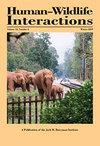利用生物能量学和雷达衍生鸟类丰度评估黑鸟栖息对向日葵季节性损害的影响
IF 0.9
4区 环境科学与生态学
Q4 BIODIVERSITY CONSERVATION
引用次数: 5
摘要
通过量化黑鸟(Icteridae)相对于环境变量的丰度并推断随后的作物损害,可以评估有效性,在这种情况下,通常会实施旨在减少鸟类对农作物损害的方法。同时,天气监测雷达(WSR)数据有可能通过改进对有害野生动物种群的监测来加强减轻作物损害。从2012年到2019年,我们使用WSR计算了美国北达科他州秋季栖息地黑鸟的每日丰度。我们将这些估计与先前开发的生物能量经济模型相结合,以估计当地向日葵(Helianthus annuus)的损害。最大的损失通常发生在10月的短时间内,此时黑鸟的丰度高峰与大比例(>50%)的成熟但未收获的向日葵田一致。大多数向日葵田的收获晚于黑鸟数量(36 - 112万只)和最大日损失(每天900 - 2000美元)的峰值。这种季节性趋势表明,提前收获时间可以作为一种策略,以避免最大的产量损失(在这一阶段最多可节省1800美元),这可以通过提前种植早熟作物品种或作物干燥来实现。本文章由计算机程序翻译,如有差异,请以英文原文为准。
Using Bioenergetics and Radar-Derived Bird Abundance to Assess the Impact of a Blackbird Roost on Seasonal Sunflower Damage
Methods aimed at reducing avian damage to agricultural crops are routinely implemented in situations where efficacy can be assessed by quantifying blackbird (Icteridae) abundance relative to environmental variables and extrapolating to ensuing crop damage. Concomitantly, Weather Surveillance Radar (WSR) data may have potential to enhance crop damage mitigation through improved monitoring of nuisance wildlife populations. We used WSR to derive daily abundance estimates of blackbirds at a fall roost in North Dakota, USA from 2012 to 2019. We integrated these estimates with previously developed bioenergeticseconomic models to estimate local sunflower (Helianthus annuus) damage. The greatest losses usually occurred during a brief period in October, when peak blackbird abundance coincided with large percentages (>50%) of mature but unharvested sunflower fields. Most sunflower fields were harvested later than peak blackbird abundance (360,000–1,120,000 birds) and maximum daily damages ($900–$2,000 USD per day). This seasonal trend suggests advancing harvest time as a strategy to avoid the greatest losses in yield (up to $1,800 in savings at this 1 roost), which may be attainable by earlier planting of early-maturing crop varieties or crop desiccation.
求助全文
通过发布文献求助,成功后即可免费获取论文全文。
去求助
来源期刊

Human–Wildlife Interactions
Environmental Science-Nature and Landscape Conservation
CiteScore
2.80
自引率
0.00%
发文量
0
审稿时长
11 weeks
期刊介绍:
Human–Wildlife Interactions (HWI) serves the professional needs of the wildlife biologist and manager in the arena of human–wildlife conflicts/interactions, wildlife damage management, and contemporary wildlife management. The intent of HWI is to publish original contributions on all aspects of contemporary wildlife management and human–wildlife interactions with an emphasis on scientific research and management case studies that identify and report innovative conservation strategies, technologies, tools, and partnerships that can enhance human–wildlife interactions by mitigating human–wildlife conflicts through direct and indirect management of wildlife and increased stakeholder engagement. Our intent is to promote a dialogue among wildlife professionals concerning contemporary management issues. As such, we hope to provide a repository for wildlife management science and case studies that document and share manager experiences and lessons learned.
 求助内容:
求助内容: 应助结果提醒方式:
应助结果提醒方式:


